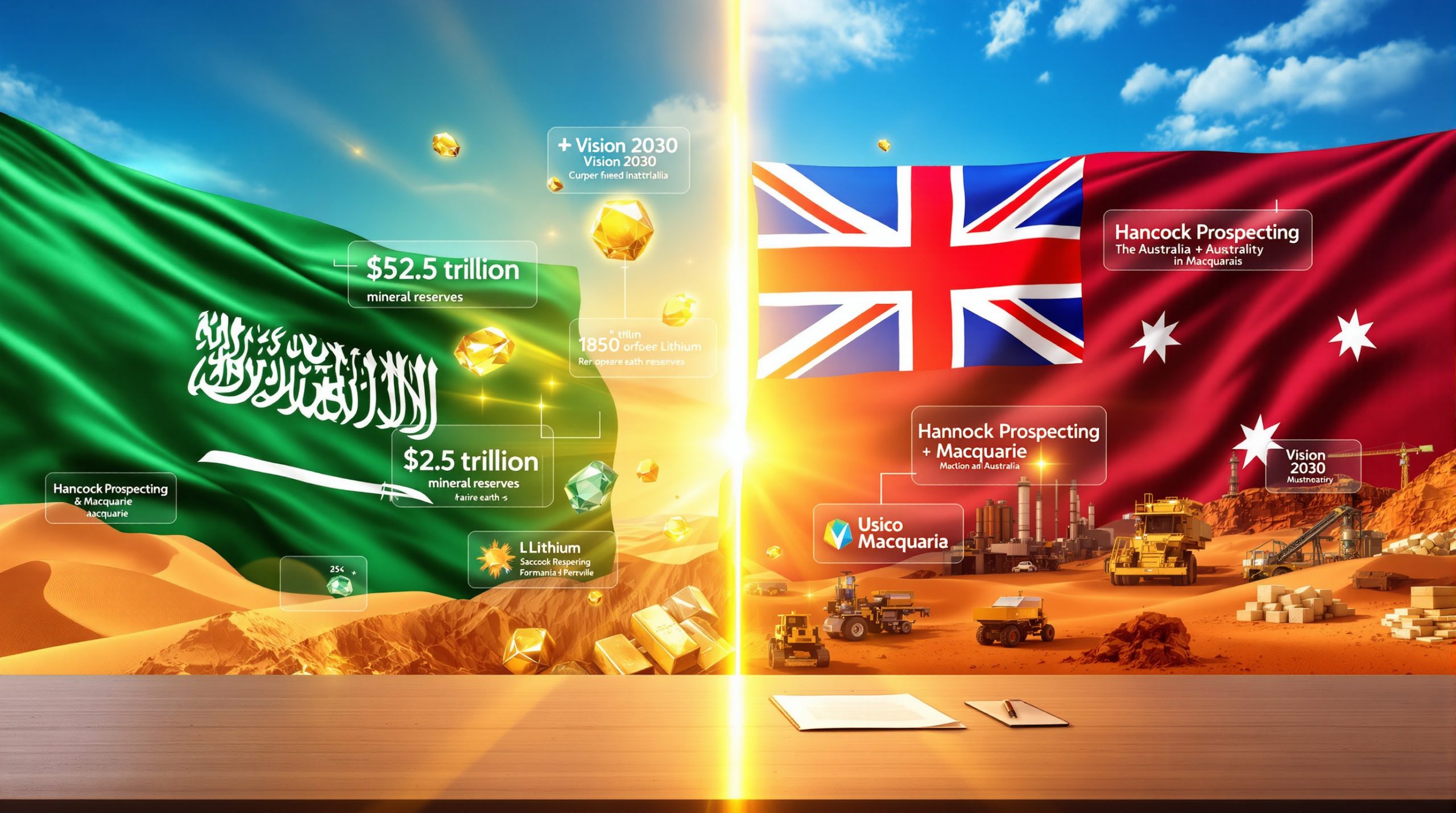The recently finalized US-Australia critical minerals deal establishes the most comprehensive bilateral resource security agreement in modern history. This strategic partnership channels over $13 billion in combined public and private investments toward securing supply chains for materials essential to semiconductors, renewable energy infrastructure, and defense technologies.
The agreement addresses longstanding vulnerabilities in Western supply chains while positioning both nations as leaders in the global transition away from fossil fuels. Through coordinated mining, processing, and technology development initiatives, the partnership creates redundant supply pathways for materials that underpin economic competitiveness and national security.
Strategic Response to Global Supply Chain Vulnerabilities
Current global supply chains for critical minerals exhibit dangerous concentration risks, particularly regarding China's dominance in rare earth processing and mineral refining operations. Beijing controls approximately 80 percent of global rare earth processing capacity and maintains significant influence over lithium, cobalt, and other strategic material markets.
The US-Australia framework directly counters these dependencies by establishing alternative supply networks within allied democratic nations. Furthermore, this diversification strategy reduces exposure to potential supply disruptions while ensuring continued access to materials essential for technological advancement and military capabilities.
Market disruptions in 2010 demonstrated the strategic vulnerability created by over-reliance on single suppliers. Chinese export restrictions on rare earth elements caused price spikes exceeding 3,000 percent and triggered widespread supply shortages across Western technology manufacturers, highlighting the need for Australia's strategic reserve initiatives.
Investment Scale and Timeline Commitments
Both governments have committed minimum $1 billion investments within the initial six-month implementation period, unlocking access to an $8.5 billion project development pipeline. The US Export-Import Bank has issued $2.2 billion in letters of interest specifically targeting Australian critical minerals ventures.
These financial commitments represent unprecedented government backing for bilateral resource development projects. The investment scale exceeds traditional mining finance models and demonstrates strategic prioritisation of supply chain security over purely market-driven development approaches.
Project timelines emphasise rapid deployment over conventional development cycles. Fast-track approval processes aim to reduce project implementation periods from decades to years, matching the urgency of energy transition security requirements in an increasingly competitive global environment.
Which Critical Minerals Are Central to This Alliance?
Gallium and Semiconductor Manufacturing
The Alcoa-Sojitz Gallium Recovery Project in Western Australia represents a breakthrough in strategic mineral extraction from existing industrial processes. This facility will supply approximately 10 percent of global gallium production by recovering the silvery metal from alumina refining waste streams.
Gallium proves essential for advanced semiconductor manufacturing, particularly gallium arsenide compounds used in high-frequency electronics, LED technology, and radar systems. Current global production concentrates in just three countries, creating strategic vulnerabilities for technology manufacturers.
The recovery approach demonstrates innovative resource utilisation by extracting valuable materials from industrial byproducts rather than dedicated mining operations. This methodology reduces environmental impact while creating additional revenue streams for existing industrial facilities.
Rare Earth Elements for Clean Energy
The Arafura Nolans project in Northern Territory targets 5 percent of global rare earth production, focusing specifically on neodymium and praseodymium essential for permanent magnet manufacturing. These elements enable wind turbine generators and electric vehicle motors that drive the global energy transition.
Heavy rare earth elements including dysprosium and terbium face particular supply constraints due to concentrated production in specific geological formations. The Northern Territory deposits contain balanced rare earth profiles suitable for high-performance magnet applications.
Processing capabilities represent the critical bottleneck in rare earth supply chains. Meanwhile, the European CRM facility initiatives demonstrate similar strategic priorities across allied nations. Raw material extraction proves relatively straightforward compared to the complex chemical separation processes required to produce market-ready rare earth compounds.
Lithium and Battery Technology
Australia's established lithium mining operations will receive expanded downstream processing capabilities to serve US battery manufacturing requirements. The framework prioritises value-added processing within allied territories rather than raw material exports to third-party refiners.
Spodumene ore from Western Australian mines currently requires processing in Chinese facilities to produce battery-grade lithium compounds. However, lithium industry innovations are creating new processing facilities that will enable direct supply to US battery manufacturers without intermediate processing dependencies.
Battery-grade lithium hydroxide commands premium pricing compared to raw spodumene ore, creating higher-value economic opportunities while securing strategic supply chains for electric vehicle and energy storage applications.
How Will the Framework Transform Mining Operations?
Accelerated Approval Processes
Both governments commit to streamlined environmental and regulatory approval procedures for designated critical minerals projects. Fast-track permitting mechanisms aim to reduce development timelines while maintaining environmental protection standards.
Traditional mining project development cycles typically span 15-20 years from exploration through production. In contrast, accelerated approval processes target 5-7 year development timelines for strategic mineral projects meeting security criteria.
Regulatory coordination between US and Australian agencies eliminates duplicative approval processes for joint development projects. Consequently, synchronised permitting reduces administrative delays while ensuring compliance with both nations' environmental and safety standards.
Price Floor Mechanisms
The agreement establishes price support systems to encourage continued production during market downturns. These mechanisms provide investment certainty for long-term mining projects requiring substantial upfront capital commitments.
Key Investment Incentives Overview:
| Incentive Category | US Commitment | Australian Commitment |
|---|---|---|
| Direct Government Investment | $1+ billion initial | $1+ billion matching |
| Export Finance Support | $2.2 billion EXIM backing | Development finance facilities |
| Market Price Support | Floor pricing mechanisms | Production stabilisation funds |
| Regulatory Streamlining | Fast-track federal approvals | Expedited state permitting |
Price volatility historically discourages mining investment due to uncertain revenue projections over multi-decade project lifecycles. Therefore, guaranteed minimum prices enable project financing while protecting against market manipulation by competitors.
What Role Does Defense Cooperation Play?
AUKUS Integration and Technology Sharing
The US-Australia critical minerals deal strengthens the existing AUKUS trilateral partnership by securing materials essential for advanced defence technologies. Australia's strategic mineral investments create reciprocal access to US military technologies while ensuring supply chain security for sensitive applications.
Nuclear submarine construction under AUKUS requires specialised materials including rare earth permanent magnets, titanium alloys, and high-performance steel formulations. Secure allied supply chains eliminate potential vulnerabilities in defence manufacturing capabilities.
Technology sharing provisions enable Australian access to advanced mining and processing techniques developed for US defence applications. This knowledge transfer accelerates capability development while maintaining security classification requirements.
Dual-Use Technology Development
Critical minerals serve both civilian and military applications, creating interdependencies between commercial markets and defence requirements. Supply security for radar systems, missile guidance, and propulsion technologies depends on continued access to strategic materials.
Gallium arsenide semiconductors enable high-frequency radar applications while supporting commercial 5G communications infrastructure. Dual-use applications create shared security interests between commercial technology development and military capabilities.
Rare earth permanent magnets power both electric vehicle motors and precision-guided munitions systems. For instance, civilian market development subsidises military applications while creating economies of scale for strategic material production.
How Does China Factor Into This Strategic Partnership?
Market Dominance and Dependency Risks
China's control over critical mineral processing creates strategic leverage that extends beyond simple market concentration. Processing facility locations, technology licensing, and export licensing decisions can influence global supply availability regardless of mining location.
Lithium processing exemplifies these dependencies, with Chinese facilities refining spodumene ore from Australian mines before re-exporting battery-grade compounds to international manufacturers. This processing bottleneck creates vulnerability points despite diverse mining operations.
Rare earth processing requires specialised chemical separation techniques and environmental management systems. Chinese facilities developed these capabilities over decades while Western nations focused on raw material extraction rather than value-added processing.
Geopolitical Response and Market Implications
Beijing has expressed concerns about supply chain fragmentation while emphasising market-driven resource allocation principles. Chinese officials warn against transforming commercial supply chains into geopolitical instruments that could destabilise global markets.
The partnership challenges China's resource leverage by creating alternative processing capabilities within allied nations. This development reduces Chinese influence over strategic material availability while potentially increasing competition for raw material inputs.
Furthermore, Trump's critical minerals order has reinforced US commitment to reducing dependencies on strategic competitors, as reported by ABC News.
Strategic Context: Historical precedents demonstrate how resource dependencies can become geopolitical weapons during international tensions. The 2010 rare earth export restrictions highlighted Western vulnerabilities to supply chain manipulation, spurring current diversification efforts.
What Economic Benefits Will Each Country Receive?
Australian Resource Sector Expansion
Australia transitions from raw material exporter to integrated supplier of refined critical minerals through access to US processing technology and financing. This transformation creates higher-value employment opportunities and industrial development beyond traditional mining operations.
Value-added processing generates significantly higher revenues compared to raw material exports. Battery-grade lithium compounds command prices 5-10 times higher than spodumene ore, creating substantial economic incentives for downstream development.
Technology transfer provisions enable Australian adoption of advanced extraction and processing methods developed for US strategic applications. This capability development accelerates industrial advancement while reducing technology development costs.
US Manufacturing and Supply Chain Security
American manufacturers secure reliable access to critical materials without geopolitical exposure through long-term supply agreements with allied suppliers. Domestic processing capabilities reduce import dependencies while creating specialised manufacturing employment.
Supply chain security enables continued innovation in semiconductors, renewable energy, and defence technologies without vulnerability to external supply disruptions. Predictable material availability supports research and development investments in next-generation applications.
Economic Impact Projections by Sector:
| Industry Sector | Australian Benefits | US Benefits |
|---|---|---|
| Mining Operations | Expanded extraction capacity | Secure strategic supply access |
| Material Processing | New refining infrastructure | Domestic processing capabilities |
| Technology Development | Advanced extraction methods | Manufacturing supply security |
| Employment Creation | High-skill technical positions | Specialised processing jobs |
Which Specific Projects Will Receive Priority Funding?
Alcoa-Sojitz Gallium Recovery Initiative
This Western Australian facility extracts gallium from existing alumina refining operations, demonstrating innovative resource recovery from industrial waste streams. The project creates new revenue opportunities while supplying strategic materials for semiconductor manufacturing.
Gallium recovery from alumina processing represents breakthrough efficiency in strategic mineral extraction. Traditional gallium production requires dedicated mining operations, whilst this approach utilises existing industrial infrastructure to recover valuable byproducts.
The facility will process approximately 200,000 tonnes of alumina annually to produce gallium compounds meeting semiconductor-grade specifications. Production capacity targets 30 tonnes of refined gallium per year, representing significant global supply addition.
Arafura Nolans Rare Earth Development
Located in Northern Territory, this integrated operation combines mining, processing, and separation facilities designed for environmental sustainability and efficient rare earth production. The project targets heavy rare earth elements essential for high-performance applications.
The Nolans deposit contains balanced rare earth element profiles suitable for permanent magnet manufacturing without requiring extensive element separation processes. This geological advantage reduces processing complexity while improving production economics.
Processing facilities will incorporate closed-loop water recycling, tailings management, and waste heat recovery systems. Environmental management approaches exceed current industry standards while demonstrating sustainable critical mineral production methods.
Emerging Battery Minerals Projects
Additional initiatives focus on cobalt, nickel, and lithium processing capabilities supporting electric vehicle and energy storage manufacturing. These projects emphasise downstream value addition rather than raw material extraction to maximise economic benefits.
Cobalt processing from nickel mining byproducts creates dual revenue streams while securing battery material supplies. This approach maximises resource utilisation while reducing environmental impact compared to dedicated cobalt mining operations.
Nickel sulfate production for battery cathode manufacturing requires specialised purification processes to achieve required chemical specifications. Therefore, new processing facilities will meet automotive industry quality standards while ensuring supply chain traceability.
What Challenges Could Impact Implementation?
Environmental and Community Considerations
Large-scale mining expansion faces environmental scrutiny regarding water usage, habitat disruption, and long-term ecological impacts. Sustainable development practices must balance resource security requirements with environmental protection commitments.
Community engagement processes require meaningful consultation with indigenous communities and local stakeholders regarding land use, cultural significance, and economic participation. Traditional ownership considerations influence project development timelines and operational approaches.
Water availability represents a critical constraint for mineral processing operations in arid Australian regions. Processing facilities require substantial water inputs for chemical separation processes, creating competition with agricultural and urban water demands.
Technical and Infrastructure Requirements
Critical mineral processing demands specialised chemical engineering expertise, advanced equipment, and sophisticated environmental management systems. Building these capabilities from limited existing capacity presents significant technical challenges.
Skilled workforce development requires extensive training programmes for specialised roles in mineral processing, chemical separation, and quality control. Current workforce capacity cannot support rapid expansion without substantial education and training investments.
Infrastructure development including power supply, transportation networks, and waste management systems requires coordination across multiple government levels. Additionally, substantial capital investment beyond direct project costs is necessary.
Market Competition and Pricing Dynamics
Global mineral markets remain highly competitive, with established suppliers potentially responding through aggressive pricing strategies or supply allocation decisions. New production must demonstrate economic viability beyond strategic considerations.
Technology competition continues advancing extraction and processing efficiency, potentially changing economic assumptions underlying current project development. Innovation risks and obsolescence considerations influence long-term project viability.
Demand forecasting difficulties create uncertainty about future market requirements for specific critical minerals. However, electric vehicle adoption rates, renewable energy deployment, and defence spending levels influence demand projections significantly.
How Will Success Be Measured and Monitored?
Supply Chain Resilience Metrics
The US-Australia Critical Minerals Supply Security Response Group will implement comprehensive monitoring systems tracking supply chain diversification, processing capacity development, and strategic reserve accumulation. Performance indicators measure progress toward supply independence objectives.
Supply chain resilience assessments evaluate alternative pathway availability, processing capacity redundancy, and emergency response capabilities. These metrics quantify reduced vulnerability to supply disruptions while maintaining cost competitiveness.
Strategic reserve targets establish minimum stockpile levels for essential materials supporting 90-day supply continuity during market disruptions. Reserve management policies balance storage costs with security benefits across different mineral categories.
Investment and Production Milestones
Success measurements include project completion timelines, production capacity achievements, and investment deployment rates. Transparent reporting mechanisms ensure accountability while demonstrating framework implementation progress.
Production milestones track actual mineral output against projected capacity targets, quality specifications, and cost benchmarks. Regular assessments identify potential delays or performance issues requiring corrective action.
Investment tracking monitors capital deployment across different project categories, geographic regions, and development phases. Furthermore, financial metrics demonstrate efficient resource utilisation while identifying funding gaps or opportunities.
What Does This Mean for Global Critical Minerals Markets?
Market Restructuring and Competition
The US-Australia critical minerals deal signals fundamental market restructuring away from single-source dependencies toward diversified supply networks among allied nations. This transformation creates multiple competitive pathways for strategic materials while reducing concentration risks.
Other allied partnerships may emerge following similar frameworks, potentially including Canada, European Union members, and other resource-rich democracies. These developments could reshape global supply chain architecture around alliance networks rather than purely economic considerations.
Market competition increases as new suppliers enter previously concentrated markets, potentially reducing prices while improving supply security. However, initial development costs may temporarily increase prices until new capacity reaches full production efficiency, as noted by CNBC's analysis.
Innovation and Technology Development
Increased investment in critical minerals drives technological innovation across extraction, processing, and recycling methods. Research and development spending accelerates as governments prioritise strategic material security alongside environmental sustainability.
Processing technology improvements could reduce costs and environmental impacts while expanding recoverable resources from lower-grade deposits. Innovation investments today establish technological leadership advantages for future market competition.
Recycling technology development gains priority as circular economy principles integrate with supply chain security objectives. Advanced recycling methods could reduce primary mineral demands while creating domestic supply sources from waste streams.
Long-term Strategic Implications
This framework establishes precedents for resource security partnerships among democratic allies, potentially extending to other strategic materials including semiconductors, advanced batteries, and specialised alloys. Success encourages broader cooperation in critical technology supply chains.
Economic blocs may increasingly organise around shared security interests rather than pure trade efficiency, creating regional supply chains aligned with geopolitical partnerships. This development represents significant departure from globalisation patterns of recent decades.
Strategic mineral security becomes integrated with broader technological competitiveness, defence capabilities, and energy transition objectives. Future international relationships may increasingly reflect resource interdependencies and supply chain resilience considerations.
Investment Considerations: Investors evaluating critical minerals opportunities should assess geopolitical alignment, technology advancement potential, and long-term supply-demand dynamics beyond traditional market metrics. Strategic partnerships create new risk-return profiles requiring specialised evaluation approaches.
Disclaimer: This analysis contains forward-looking statements and speculative assessments based on publicly available information. Actual outcomes may differ significantly from projections due to market conditions, technological developments, regulatory changes, or geopolitical events. Investment decisions should incorporate comprehensive due diligence and professional advisory services.
Ready to Capitalise on Critical Minerals Investment Opportunities?
The US-Australia critical minerals partnership creates unprecedented opportunities for investors targeting strategic resource companies on the ASX. Discovery Alert's proprietary Discovery IQ model delivers instant notifications when Australian miners announce significant discoveries in lithium, rare earths, and other critical minerals, ensuring you're positioned ahead of the market when the next major breakthrough hits the headlines.




